flat tire HONDA RIDGELINE 2014 1.G Owners Manual
[x] Cancel search | Manufacturer: HONDA, Model Year: 2014, Model line: RIDGELINE, Model: HONDA RIDGELINE 2014 1.GPages: 422, PDF Size: 9.32 MB
Page 77 of 422
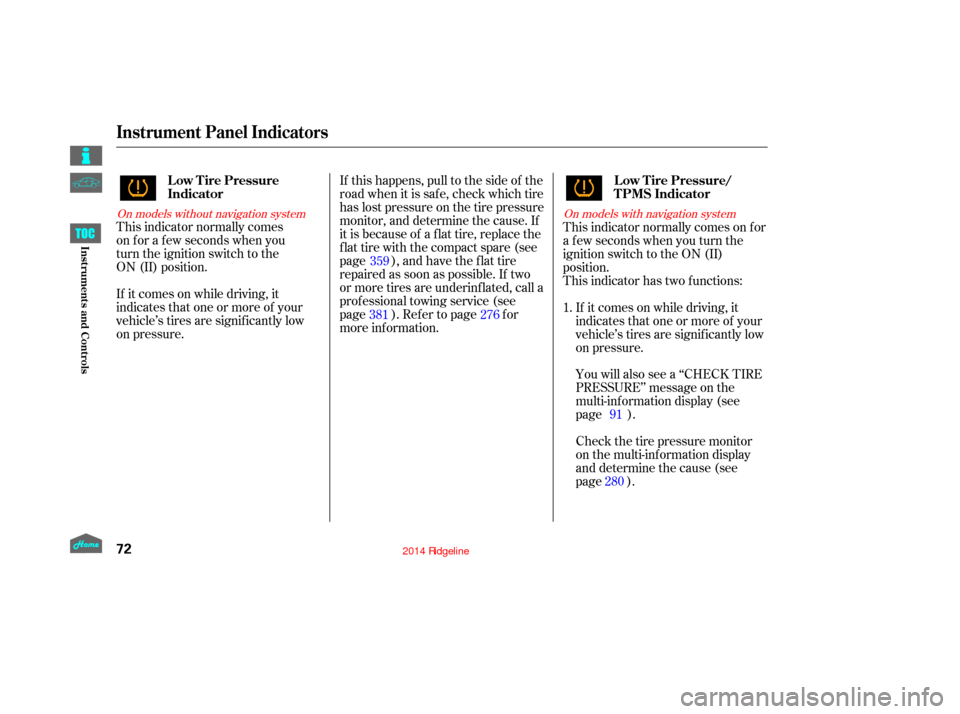
If it comes on while driving, it
indicates that one or more of your
vehicle’s tires are signif icantly low
on pressure. This indicator normally comes
on for a few seconds when you
turn the ignition switch to the
ON (II) position.If this happens, pull to the side of the
road when it is saf e, check which tire
has lost pressure on the tire pressure
monitor, and determine the cause. If
it is because of a f lat tire, replace the
flat tire with the compact spare (see
page ), and have the flat tire
repaired as soon as possible. If two
or more tires are underinf lated, call a
prof essional towing service (see
page ). Ref er to page f or
more inf ormation.This indicator normally comes on f or
a f ew seconds when you turn the
ignition switch to the ON (II)
position.
This indicator has two f unctions:
Check the tire pressure monitor
on the multi-information display
and determine the cause (see
page ).
You will also see a ‘‘CHECK TIRE
PRESSURE’’ message on the
multi-inf ormation display (see
page ). If it comes on while driving, it
indicates that one or more of your
vehicle’s tires are signif icantly low
on pressure.
1.
91
359
381 276
280
On models without navigation system On models with navigation system
Low Tire Pressure
IndicatorLow Tire Pressure/
TPMS Indicator
Instrument Panel Indicators
72
12/08/09 16:08:44 31SJC670_079
Inst rument s and Cont rols
Page 78 of 422
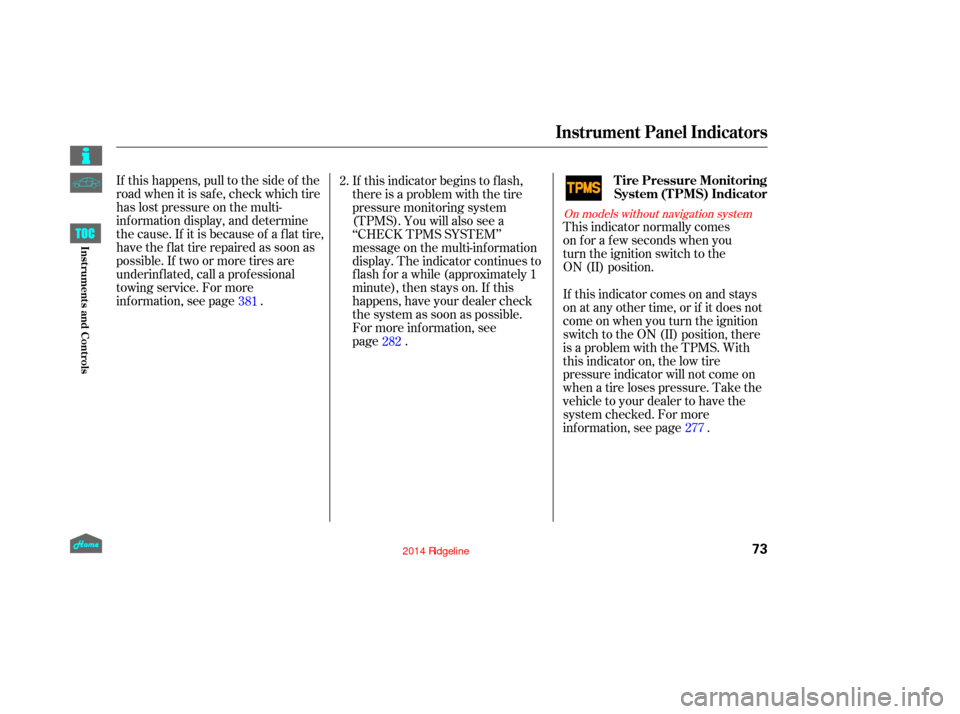
This indicator normally comes
on for a few seconds when you
turn the ignition switch to the
ON (II) position.
If this happens, pull to the side of the
road when it is saf e, check which tire
has lost pressure on the multi-
inf ormation display, and determine
the cause. If it is because of a flat tire,
have the flat tire repaired as soon as
possible. If two or more tires are
underinf lated, call a prof essional
towing service. For more
inf ormation, see page . If this indicator begins to flash,
there is a problem with the tire
pressure monitoring system
(TPMS). You will also see a
‘‘CHECK TPMS SYSTEM’’
message on the multi-information
display. The indicator continues to
flash for a while (approximately 1
minute), then stays on. If this
happens, have your dealer check
the system as soon as possible.
For more information, see
page
. If this indicator comes on and stays
on at any other time, or if it does not
come on when you turn the ignition
switch to the ON (II) position, there
is a problem with the TPMS. With
this indicator on, the low tire
pressure indicator will not come on
when a tire loses pressure. Take the
vehicle to your dealer to have the
system checked. For more
inf ormation, see page .
2.
381 282
277
On models without navigation system
Tire Pressure Monitoring
System (T PMS) Indicator
Instrument Panel Indicators
73
12/08/09 16:08:51 31SJC670_080
Inst rument s and Cont rols
Page 91 of 422
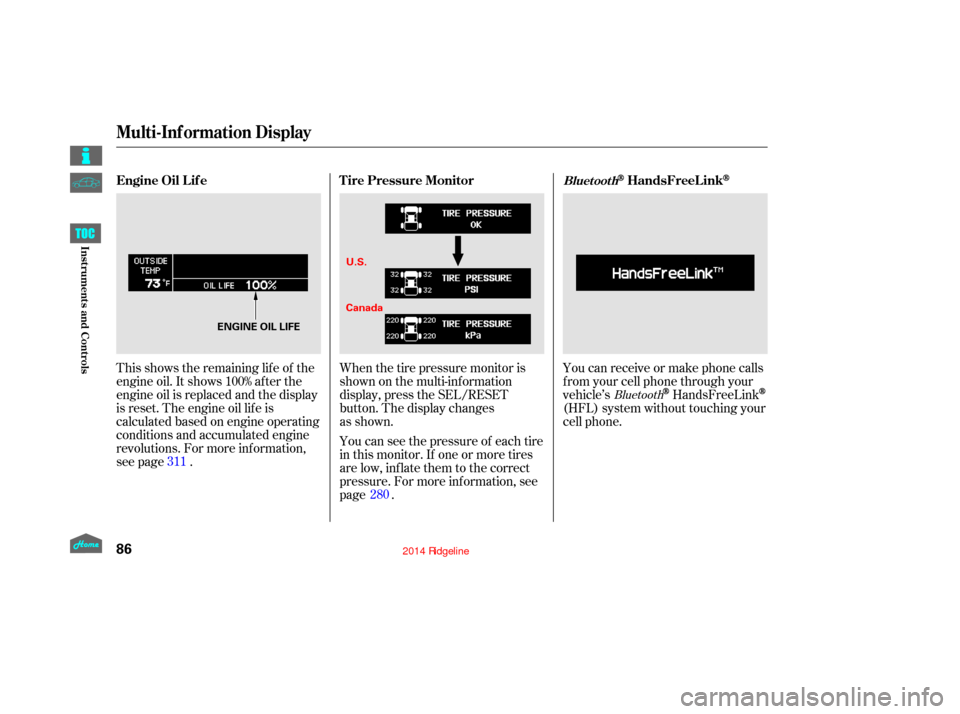
This shows the remaining lif e of the
engine oil. It shows 100% af ter the
engine oil is replaced and the display
is reset. The engine oil lif e is
calculated based on engine operating
conditions and accumulated engine
revolutions. For more inf ormation,
see page .When the tire pressure monitor is
shown on the multi-information
display, press the SEL/RESET
button. The display changes
as shown.
You can see the pressure of each tire
in this monitor. If one or more tires
are low, inflate them to the correct
pressure. For more inf ormation, see
page .You can receive or make phone calls
f rom your cell phone through your
vehicle’s
HandsFreeLink
(HFL) system without touching your
cell phone.
311 280
Bluetooth
Engine Oil L if e T ire Pressure MonitorHandsFreeL inkBluet oot h
Multi-Inf ormation Display
86
ENGINE OIL LIFEU.S.
Canada
12/08/09 16:10:28 31SJC670_093
Inst rument s and Cont rols
Page 282 of 422
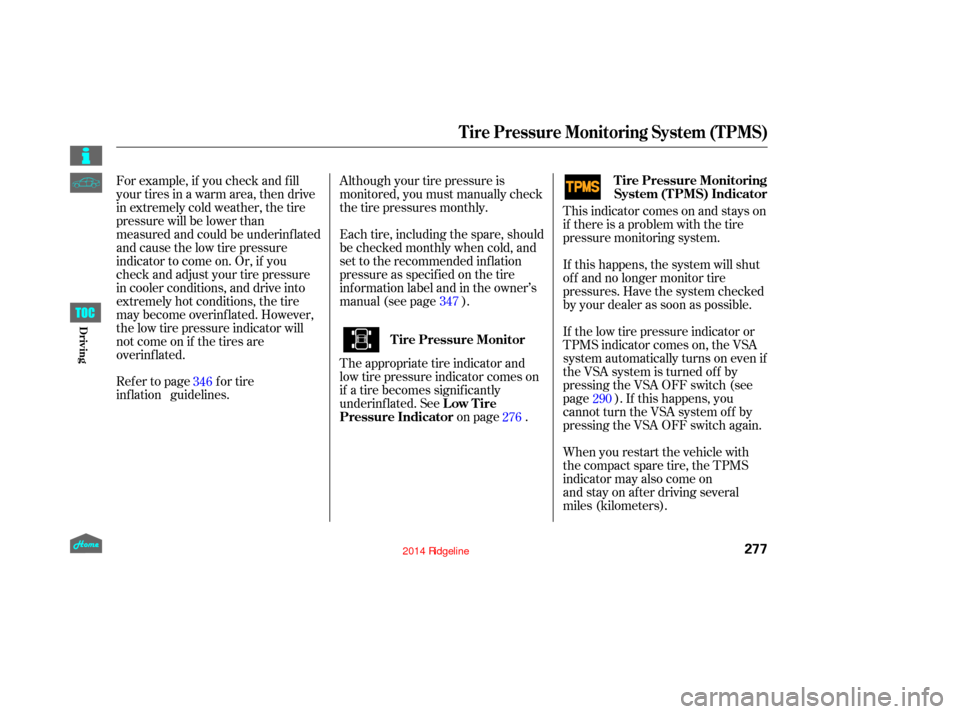
This indicator comes on and stays on
if there is a problem with the tire
pressure monitoring system.
If this happens, the system will shut
of f and no longer monitor tire
pressures. Have the system checked
by your dealer as soon as possible.
If the low tire pressure indicator or
TPMS indicator comes on, the VSA
system automatically turns on even if
the VSA system is turned of f by
pressing the VSA OFF switch (see
page ). If this happens, you
cannot turn the VSA system of f by
pressing the VSA OFF switch again.
Although your tire pressure is
monitored, you must manually check
thetirepressuresmonthly.
The appropriate tire indicator and
low tire pressure indicator comes on
if a tire becomes signif icantly
underinf lated. See
on page .
For example, if you check and f ill
your tires in a warm area, then drive
in extremely cold weather, the tire
pressure will be lower than
measured and could be underinf lated
and cause the low tire pressure
indicator to come on. Or, if you
check and adjust your tire pressure
in cooler conditions, and drive into
extremely hot conditions, the tire
maybecomeoverinflated.However,
the low tire pressure indicator will
not come on if the tires are
overinf lated.
Refer to page for tire
inflation guidelines.
When you restart the vehicle with
the compact spare tire, the TPMS
indicator may also come on
and stay on after driving several
miles (kilometers).
Each tire, including the spare, should
be checked monthly when cold, and
set to the recommended inf lation
pressure as specif ied on the tire
information label and in the owner’s
manual (see page ).
346 347
276 290
Tire Pressure Monitoring System (TPMS)
Tire Pressure Monitoring
System (T PMS) Indicator
T ire Pressure Monitor Low Tire
Pressure Indicator
277
12/08/09 16:35:50 31SJC670_284
Driving
Page 283 of 422

If you have a flat tire, the low tire
pressure indicator will come on.
Replace the indicated flat tire with
the compact spare tire (see
page).
Each wheel (except the compact
sparetirewheel)isequippedwitha
tire pressure sensor. You must use
TPMS specif ic wheels. It is
recommended that you always have
your tires serviced by your dealer or
qualif ied technician.
After you replace the flat tire with
thecompactsparetire,thelowtire
pressure indicator stays on. This is
normal; the system is not monitoring
the spare tire pressure. Manually
check the spare tire pressure to be
sure it is correct. Af ter several miles
(kilometers) driving with the
compact spare tire, the TPMS
indicator comes on and the low tire
pressure indicator goes of f . The low tire pressure indicator or
the TPMS indicator will go off, after
several miles (kilometers) driving,
when you replace the spare tire with
the specif ied regular tire equipped
with the tire pressure monitor sensor.
Never use a puncture-repairing agent
in a f lat tire. If used, you will have to
replace the tire pressure sensor.
Havetheflattirerepairedbyyour
dealer as soon as possible.
This device complies with the
appropriate requirements or the
required standards. See page f or
more inf ormation.
358 400
Tire Pressure Monitoring System (TPMS)
Changing a T ire with T PMS
278
12/08/09 16:35:56 31SJC670_285
Driving
Page 284 of 422
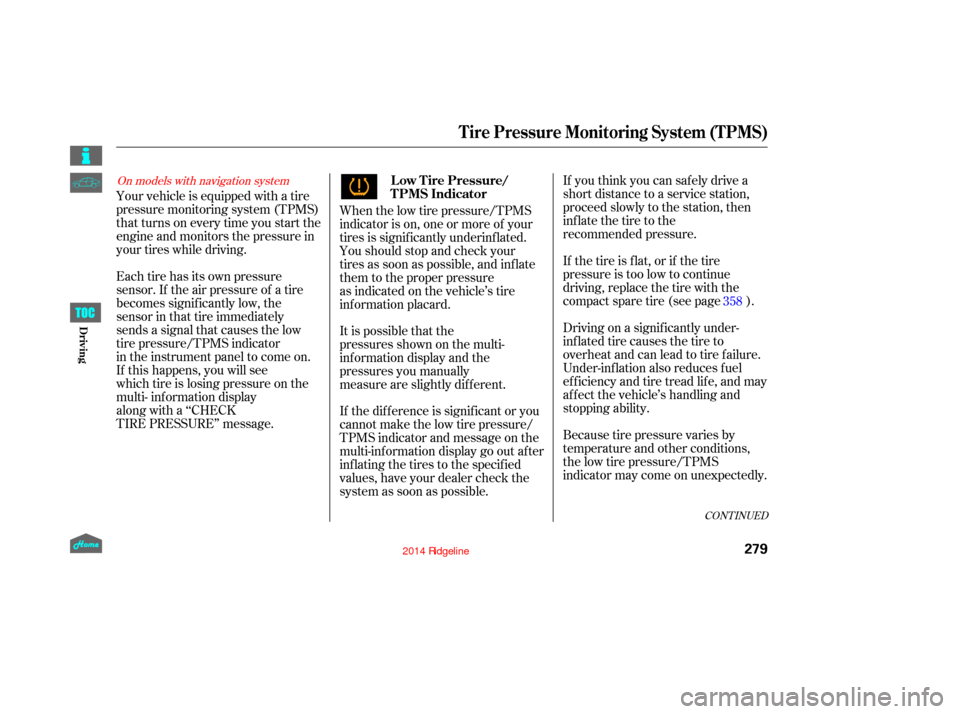
CONT INUED
If you think you can safely drive a
short distance to a service station,
proceed slowly to the station, then
inflate the tire to the
recommended pressure.
If the tire is f lat, or if the tire
pressure is too low to continue
driving, replace the tire with the
compact spare tire (see page ).
Driving on a signif icantly under-
inf lated tire causes the tire to
overheat and can lead to tire failure.
Under-inf lation also reduces f uel
efficiency and tire tread life, and may
af f ect the vehicle’s handling and
stopping ability.
Becausetirepressurevariesby
temperature and other conditions,
the low tire pressure/TPMS
indicator may come on unexpectedly.
When the low tire pressure/TPMS
indicator is on, one or more of your
tires is significantly underinflated.
You should stop and check your
tires as soon as possible, and inflate
them to the proper pressure
as indicated on the vehicle’s tire
information placard.
It is possible that the
pressures shown on the multi-
information display and the
pressures you manually
measure are slightly different.
If the dif f erence is signif icant or you
cannot make the low tire pressure/
TPMS indicator and message on the
multi-inf ormation display go out af ter
inf lating the tires to the specif ied
values, have your dealer check the
system as soon as possible.
Each tire has its own pressure
sensor. If the air pressure of a tire
becomes significantly low, the
sensor in that tire immediately
sends a signal that causes the low
tire pressure/TPMS indicator
in the instrument panel to come on.
If this happens, you will see
which tire is losing pressure on the
multi- information display
along with a ‘‘CHECK
TIRE PRESSURE’’ message. Your vehicle is equipped with a tire
pressure monitoring system (TPMS)
that turns on every time you start the
engine and monitors the pressure in
your tires while driving.
358On models with navigation systemLow Tire Pressure/
TPMS Indicator
Tire Pressure Monitoring System (TPMS)
279
12/08/09 16:36:04 31SJC670_286
Driving
Page 285 of 422
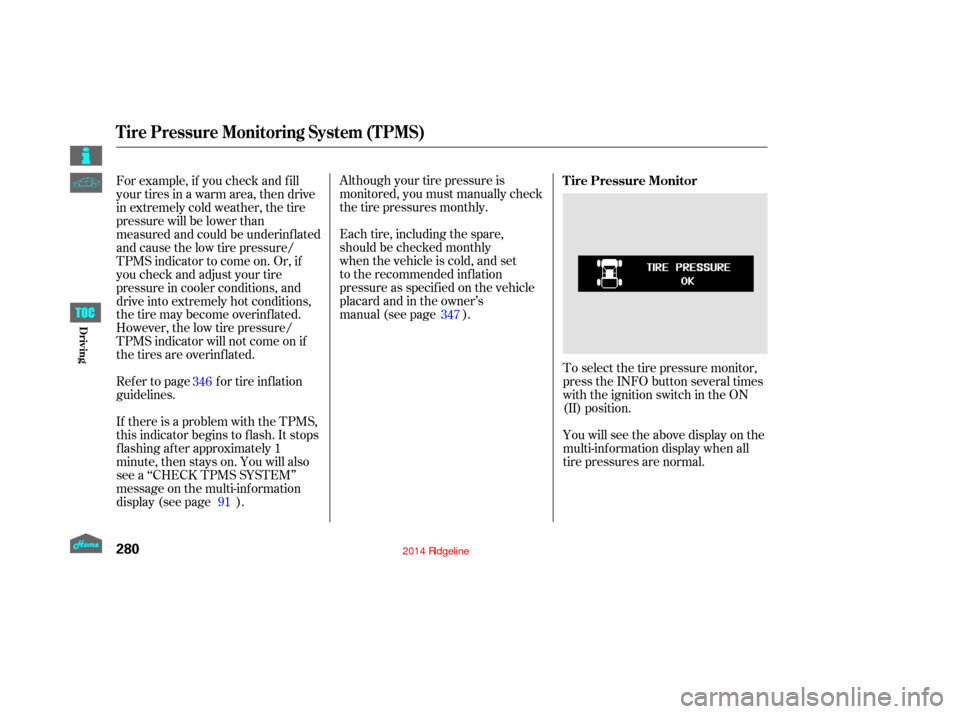
Although your tire pressure is
monitored, you must manually check
thetirepressuresmonthly.
Each tire, including the spare,
should be checked monthly
when the vehicle is cold, and set
to the recommended inflation
pressure as specified on the vehicle
placard and in the owner’s
manual (see page).
Toselectthetirepressuremonitor,
press the INFO button several times
with the ignition switch in the ON
(II) position.
You will see the above display on the
multi-inf ormation display when all
tire pressures are normal.
For example, if you check and f ill
your tires in a warm area, then drive
in extremely cold weather, the tire
pressure will be lower than
measured and could be underinf lated
and cause the low tire pressure/
TPMS indicator to come on. Or, if
youcheckandadjustyourtire
pressure in cooler conditions, and
drive into extremely hot conditions,
the tire may become overinf lated.
However, the low tire pressure/
TPMS indicator will not come on if
thetiresareoverinflated.
Refer to page for tire inflation
guidelines.
If there is a problem with the TPMS,
this indicator begins to f lash. It stops
flashing after approximately 1
minute, then stays on. You will also
see a ‘‘CHECK TPMS SYSTEM’’
message on the multi-inf ormation
display (see page ).
91
346
347Tire Pressure Monitor
Tire Pressure Monitoring System (TPMS)
280
12/08/09 16:36:11 31SJC670_287
Driving
Page 288 of 422

If the low tire pressure/TPMS
indicator comes on, or the multi-
inf ormation display shows a
‘‘CHECK TPMS SYSTEM’’ message,
the VSA system automatically turns
on even when the VSA system is
turned of f by pressing the VSA OFF
switch (see page ). If this
happens, you cannot turn the VSA
system of f by pressing the VSA OFF
switch again.
When you restart the vehicle with
thecompactsparetire,theTPMS
system message will also be
displayed on the multi-inf ormation
display af ter several miles
(kilometers) driving.This indicator and the warning
message on the multi-information
display will go of f , af ter several miles
(kilometers) driving, when the spare
tire is replaced with the specified
regular tire equipped with the tire
pressure monitor sensor.
If you have a f lat tire, the low tire
pressure/TPMS and tire monitor
indicators will come on. Replace the
indicated f lat tire with the compact
sparetire(seepage ).
After the flat tire is replaced
with the spare tire, the low tire
pressure/ TPMS indicator
stays on while driving. After
several miles (kilometers) driving,
this indicator begins to flash,
then stays on again.
You will also see a ‘‘CHECK TPMS
SYSTEM’’ message on the multi-
information display. This is normal;
the system cannot monitor the
spare tire pressure. Manually check
the spare tire pressure to be sure it
is correct. Each wheel (except the compact
sparetirewheel)isequippedwitha
tire pressure sensor. You must use
TPMS specif ic wheels. It is
recommended that you always have
your tires serviced by your dealer or
qualif ied technician.
Never use a puncture-repairing agent
in a f lat tire. If used, you will have to
replace the tire pressure sensor.
Havetheflattirerepairedbyyour
dealer as soon as possible.
290
358
CONT INUED
Tire Pressure Monitoring System (TPMS)
Changing a T ire with T PMS
283
12/08/09 16:36:31 31SJC670_290
Driving
Page 302 of 422

Always use saf ety chains when you
tow a trailer. Make sure the chains
are secured to the trailer and hitch,
and that they cross under the tongue
and can catch the trailer if it
becomes unhitched. Leave enough
slack to allow the trailer to turn
corners easily, but do not let the
chains drag on the ground.When towing a trailer, we
recommend that you carry a f ull-size
spare wheel and tire for your vehicle
and trailer. See page f or proper
tire size, page f or how to store a
full size wheel and tire, and page
f or inf ormation on changing a
flat tire.
Remember to unhitch the trailer
before changing a flat. Ask your
trailer sales or rental agency
where and how to store the
trailer’s spare tire.
This device is recommended if your
trailer tends to sway. Your trailer
dealer or rental agency can tell you
what kind of sway control you need
and how to install it.
Many states and provinces require
special exterior mirrors when towing
a trailer. Even if they don’t, you
should install special mirrors if you
cannot clearly see behind you, or if
the trailer creates a blind spot. 350
364
359
Saf et y Chains
Sway Cont rol Spare Tires
Trailer Mirrors
Towing a Trailer
297
12/08/09 16:38:20 31SJC670_304
Driving
Page 306 of 422

The added weight, length, and
height of a trailer will affect your
vehicle’s handling and performance,
so driving with a trailer requires
some special driving skills
and techniques.
The vehicle has been properly
serviced, and the tires, brakes,
suspension, cooling system,
and lights are in good
operating condition.
The trailer has been properly
serviced and is in good condition.
All weights and loads are
within limits.
Thehitch,safetychains,andany
other attachments are secure.
Allitemsonandinthetrailerare
properly secured and cannot shif t
while you drive.
When preparing to tow, and
before driving away, be sure to
check the following:
Towing performance can be
affected by high altitude, high
temperature, or when climbing
steep grades. Therefore,
premium fuel (premium
unleaded gasoline
with pump octane number
of 91 or higher)
is recommended when
towing more than
3,500 lbs (1,590 kg). The trailer tires and spare are
in good condition and
inflated as recommended by
the trailer maker. Your vehicle tires and spare
are in good condition and
properly inflated. The lights and brakes on your
vehicle and the trailer are
working properly.Foryoursafetyandthesafetyof
others,taketimetopracticedriving
maneuvers bef ore heading f or the
open road, and f ollow the guidelines
on thef ollowing page.
CONT INUED
Driving Saf ely With a T railer
Pre-T ow Checklist
Towing a Trailer
301
12/08/09 16:38:56 31SJC670_308
Driving